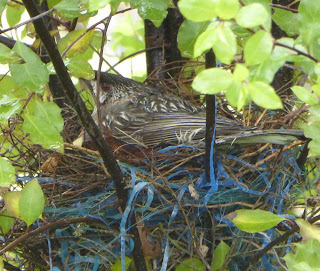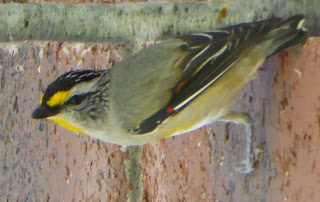The migrants have pretty much all returned . This includes some less common species
including Brown Songlark on the Hoskinstown Plain and Masked and White-browed
Woodswallows in a number of sites. Among
the less common migrant species not yet reported are the 2 large cuckoos:
Eastern Koel and Channel-billed Cuckoo.
If anyone sees (or more likely hears) either of them please let me know.
No new species have been added to the list this month but there have been some unusual sightings;
Breeding is also happening in a major way: 25 species have been reported breeding, which is the equal highest monthly score in the 7 years of this project. Our Tawny Frogmouths are now brooding a single chick which is in wing-stretching mode (its nest mate fell out of the nest and didn’t survive the experience). A particularly good haul of breeding records was gathered during a visit to a snow gum/brittle gum woodland off Pollack Rd. Less well received was Sericornis frontalis illegitimalis (the bastard scrubwren) which built an indoor nest in an observers skein of garlic!
- a juvenile White-bellied Sea-Eagle from Hoskinstown - perhaps a link to the pair seen flying from that direction in July
- a female Satin Flycatcher in the Molonglo Valley (2nd for the project) was almost certainly en route to the damp gullies of Tallanganda;
- a Yellow-billed Spoonbill was seen on Foxlow Lagoon which is only the 4th sighting in close to 7 years.
- I have also had a report of an Eastern Barn Owl from Radcliffe, rather than the more common location on the Hoskinstown Plain.
Breeding is also happening in a major way: 25 species have been reported breeding, which is the equal highest monthly score in the 7 years of this project. Our Tawny Frogmouths are now brooding a single chick which is in wing-stretching mode (its nest mate fell out of the nest and didn’t survive the experience). A particularly good haul of breeding records was gathered during a visit to a snow gum/brittle gum woodland off Pollack Rd. Less well received was Sericornis frontalis illegitimalis (the bastard scrubwren) which built an indoor nest in an observers skein of garlic!
This image of a Red Wattlebird is from Hillview Nursery (after the photo was taken a second bird appeared and fed young in the nest).
Thanks to observers in Pony Place, Wanna Wanna Rd, Captains Flat Rd, Radcliffe, Bowen St, Widgiewa Rd, Molonglo Valley,the Hoskinstown Plain and Hoskinstown. Keep them coming people!
1 Waterbirds: Musk Duck; Black Swan; Australian Shelduck; Australian Wood Duck; Grey Teal; Pacific Black Duck; Hardhead;Australasian Grebe; Little Black Cormorant; Little Pied Cormorant; White‑necked Heron; White‑faced Heron; Yellow-billed Spoonbill; EurasianCoot; Black‑fronted Dotterel; Masked Lapwing; Banded Lapwing;
2 Birds of Prey: Black-shouldered Kite; White-bellied Sea-eagle; Brown Goshawk; Spotted Harrier; Wedge-tailed Eagle; Little Eagle; Nankeen Kestrel; Peregrine Falcon.
3 Parrots and Relatives: Yellow-tailed Black-cockatoo;Gang‑gang Cockatoo; Galah; Sulphur‑crested Cockatoo; Australian King‑parrot; Crimson Rosella; Eastern Rosella; Red-rumped parrot
4 Kingfishers and other non-songbirds:Stubble Quail; Brown quail; Common Bronzewing; Crested Pigeon; Tawny Frogmouth; Painted Button-quail; Common Koel; Channel-billed Cuckoo;Horsfield's Bronze‑Cuckoo; Shining Bronze‑cuckoo; Pallid Cuckoo; Fan‑tailed Cuckoo; Brush Cuckoo; Eastern Barn Owl; Laughing Kookaburra; Sacred Kingfisher; Dollarbird;
5 Honeyeaters: Eastern Spinebill; Yellow-faced Honeyeater; White-eared Honeyeater; Noisy Miner; Red Wattlebird; New Holland Honeyeater; Brown‑headed Honeyeater; White-naped Honeyeater; Noisy Friarbird
6 Flycatchers and similar species: Golden Whistler;Rufous Whistler; Grey Shrike-thrush; Grey Fantail; WillieWagtail; Leaden Flycatcher; Satin Flycatcher; Magpie-lark; Scarlet Robin; Flame Robin; Rose Robin, Eastern Yellow Robin;Welcome Swallow; Fairy Martin; Tree Martin
7 Thornbills, Finches and similar species: Superb Fairy-wren; White-browed Scrubwren; Weebill; White-throated Gerygone; Striated Thornbill; Yellow‑rumped Thornbill; Buff‑rumped Thornbill; Brown Thornbill; Southern Whiteface; Spotted Pardalote; Striated Pardalote; Silvereye; Double‑barred Finch; Red‑browed Finch; Diamond Firetail; House Sparrow; European Goldfinch
8 Other, smaller birds: White-throated Treecreeper; Black-faced Cuckoo-shrike; White‑-winged Triller; Olive‑backed Oriole; Masked Woodswallow; White‑browed Woodswallow; Dusky Woodswallow;Skylark; Golden-headed Cisticola; Rufous Songlark; Brown Songlark; Common Blackbird; Common Starling; Mistletoebird; Australasian Pipit;
9 Other, larger birds: Satin Bowerbird; Grey Butcherbird; Australian Magpie; Pied Currawong;Grey Currawong; Australian Raven; Little Raven; White-winged Chough
Although they are an introduced species, and in this image is sitting on an evil Pinus radiata, I do find this male Common Blackbird singing his heart out as we start our dog walk in the morning is an uplifting experience.



































